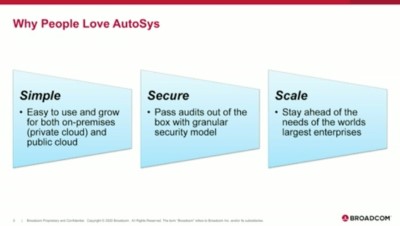AutoSys Workload Automation
A solution that enables organizations to combine and use disparate processing silos into an end to end, cohesive, orchestrated workflow. The goal of workload automation is to enable IT management to gain application visibility and accessibility across their computing environment.
AutoSys Workload Automation enhances visibility and control of complex workloads across platforms, ERP systems, and the cloud. It helps to reduce the cost and complexity of managing mission critical business processes, ensuring consistent and reliable service delivery.

Improve the availability of your critical application workloads
- Reduced cost and complexity managing workloads across platforms
- Enhanced business responsiveness through dynamic workload placement across physical, virtualized and cloud environments
- Integrations with major business applications to be managed with reliability and flexibility and to be executed in sync with enterprise workflows
- Forecasting, notifications and automatic actions for overdue jobs
Enable the future of your business workloads portability
- Deployment either entirely or partially in a private/public cloud, traditional on-premise or in a hybrid environment
- Natively support for both SOAP and REST web service protocols
- Dynamic workload placement across physical, virtual and cloud resources to optimize utilization and handle spikes in processing
- Web service allowing developers to write queries against automation engines
AutoSys Workload Automation Benefits
Allows you to manage and visualize a business process end-to-end, across platforms, from a central point of control.
Helps you understand the business impact of critical errors and facilitates improved communication and coordination to prioritize and respond to a potential problem.
Enables users to add Big Data jobs to their existing workflows along with other traditional jobs and to be able to monitor their end-to-end workflows from a single console without having to go through multiple schedulers
Reduces and simplifies scheduling definitions, allowing managers to define schedules and calendars once and reuse them many times
Enables management by exception through dynamic critical path, automatic alerting, and notifications.
Increases application scalability and performance instead of waiting for an event to complete before triggering the next one
